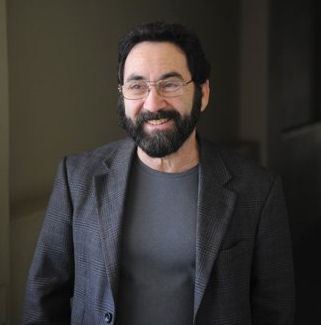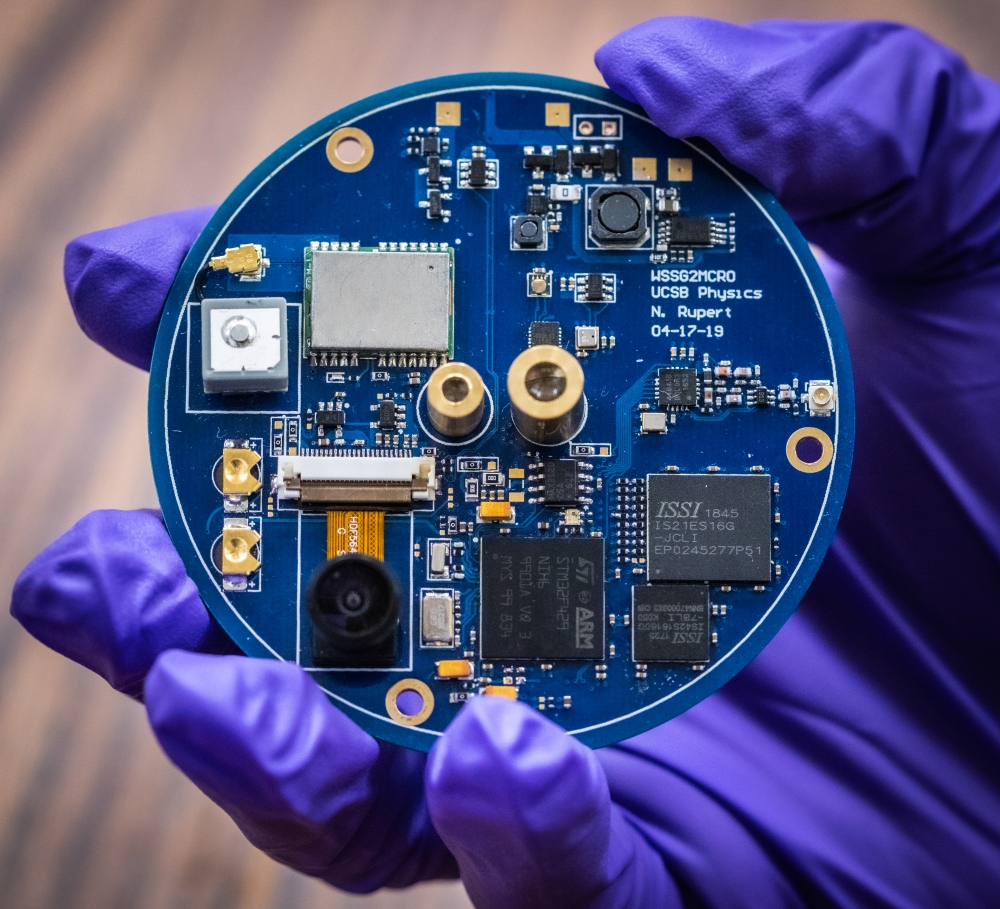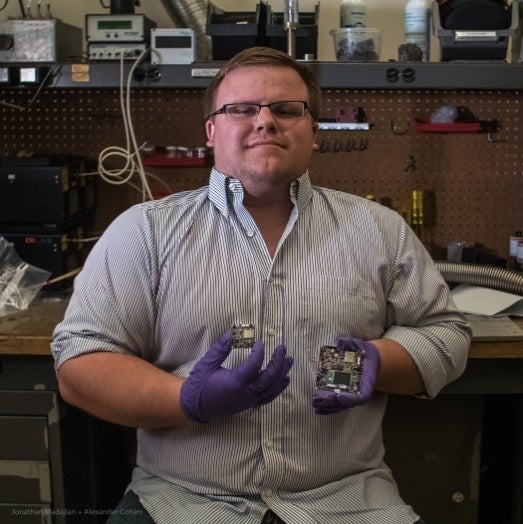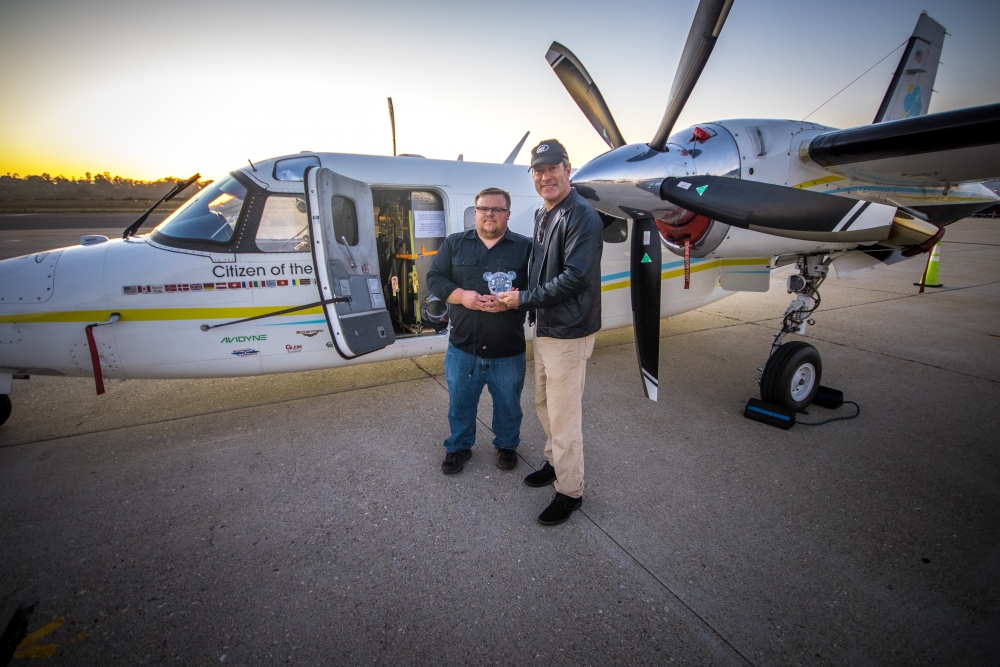From the Poles to the Stars

On November 16, 2019, pilot and author Robert DeLaurentis took off on an ambitious adventure. Setting out from San Diego county’s Gillespie Field, he banked toward Grand Prairie, Texas on the first leg of a pole to pole expedition. At each stop along the way he planned to talk about STEM education, aviation safety and technology, all with the intention of encouraging and inspiring the next generation.
Most of the cargo space in his modified 1983 twin-engine aircraft, dubbed “Citizen of the World,” had been outfitted with extra fuel tanks for the long voyage, but he did have room for a small device courtesy of researchers at UC Santa Barbara: a wafer-scale spacecraft (WSS).
The miniature satellite is the work of physics professor Philip Lubin, development technician Nic Rupert, postdoctoral researcher Peter Krogen and undergraduate student Varun Iyer. It’s part of project Starlight, a NASA-backed effort to develop a spacecraft and propulsion system that can reach the nearest extra-solar system within a human lifetime.
The concept is a radical departure from conventional practice. The usual setup is to launch a spacecraft with a propulsion system to get it to its destination. Starlight takes a different tack: Leave the bulky propulsion system on Earth, and beam the energy at the spacecraft using high-power lasers.

The wafer-scale spacecraft on the flight.
Photo Credit: NIC RUPERT
This unconventional idea enables scientists to miniaturize the craft to the point where it could be accelerated to a significant fraction of the speed of light. This would cut a trip to the nearest star system — Alpha Centauri — from 100,000 years to around 20 years.
“Chemistry is a dead end for going interstellar,” Lubin said, referring to conventional rocket propellant. Laser propulsion should enable the craft to achieve speeds fast enough that it can reach nearby stars within a nominal human lifetime.
Lubin and his team recognize the broader significance of their project. “Part of our program, while being very technical, tries to inspire people as to the possibilities of human exploration,” he said.
This aspect was not lost on DeLaurentis, who met Lubin while visiting Santa Barbara with friend and fellow pilot Brian Keating, a cosmology professor at UC San Diego. “This trip is about taking the plane and pilot to their absolute limits,” said DeLaurentis, “and I think this wafer-scale spaceship takes our knowledge to its absolute limits, too.”
And, as DeLaurentis added, “aviation is really the first step in moving towards the stars.”
The lab provided the pilot with a WSS, which he named Francis, after his late mother. It plugged into a USB port and lived on one of the windows behind the copilot’s seat. “It took pictures, it measured altitude, temperature, speed, location,” he said, “and it was just basically pointed out the window the whole time.”
Spacecraft onboard, Delaurentis navigated his way south from Texas, stopping in Panama, Columbia, Bolivia and Argentina. The Citizen of the World successfully crossed the South Pole on December 17, 2019 — the 116th anniversary of the Wright Brothers’ first flight. The transit over both north and south poles was powered completely by biofuel.

Nic Rupert
Despite weighing just under 1 ¼ ounces, the spacecraft packed a diverse array of sensors. It featured a 5-megapixel camera, ambient light detector, GPS system, pressure and humidity sensor, two thermometers and a nine-axis inertial measurement unit. The team plans to shrink the spacecraft even further in the future. “We’d like to make a spacecraft that can almost be printed out like a processor,” said senior engineer Nic Rupert.
Starlight is a long-term project, with a timeframe comparable to the development of rockets beginning before WWII to the launch of Apollo 11. It took decades of work that wasn’t necessarily targeted toward going to the moon in order to land the crew of Apollo 11, Lubin said. Except, whereas the space race was driven by military research during the Cold War, Starlight is driven by civilian work in the consumer tech market.
The spacecraft’s journey north was much more hectic. The Citizen of the World was fortunate to be able to depart from Italy just before the country closed in March. At that point the expedition was almost cut short when COVID-19 hit Europe. Delaurentis and the WSS headed to the closest country that was still open, Spain, where he spent six weeks in quarantine as the pandemic swept across the continent.
Once restrictions eased, the plane and spacecraft headed to Sweden, where the trip stalled for another month. The plan had been to fly to the Norwegian island of Svalbard, but clearance wouldn’t come from the Norwegian government. Undeterred, DeLaurentis flew 11.5 hours, directly from Kiruna, Sweden to Fairbanks, Alaska. En route, pilot, plane and spacecraft passed over the magnetic and geographic north poles, as well as the north pole of inaccessibility.
During that leg, DeLaurentis unexpectedly found himself without navigation or autopilot. He was surrounded by five hours of water on all sides, without even the stars to guide him during the polar summer’s 24-hour daylight.
Fortunately the pilot’s tablet still functioned, and he was able to safely navigate to Fairbanks.
The spacecraft, however, encountered no such issues. “Our instrumentation was working just fine, even over the poles,” said Iyer. “We have uninterrupted GPS and inertial measurement unit data for both of the flights that took Robert over the poles.” This bodes well for its reliability on the long journey to Alpha Centauri.
Though the pandemic threatened to ground the entire expedition, the team persevered, and ultimately succeeded. Citizen of the World touched back down at Gillespie Field on August 10, 2020. The WSS Francis returned to its home in the Lubin Lab shortly thereafter, at which point the team downloaded all the data it had recorded onto its onboard microSD card.
The researchers have used the data to understand how the craft performed. “It has made us aware of some issues with the device automatically resetting itself from time to time with no apparent cause,” explained Iyer, “an issue that we hadn’t previously observed in a lab setting.”
As for the WSS itself: “Francis has completed her mission and everything was a success,” said Rupert. “We learned quite a lot from this experiment, and found many new ways to refine and streamline the prototype. Francis has now been retired. She occupies a nice spot on the shelf next to her siblings.”





